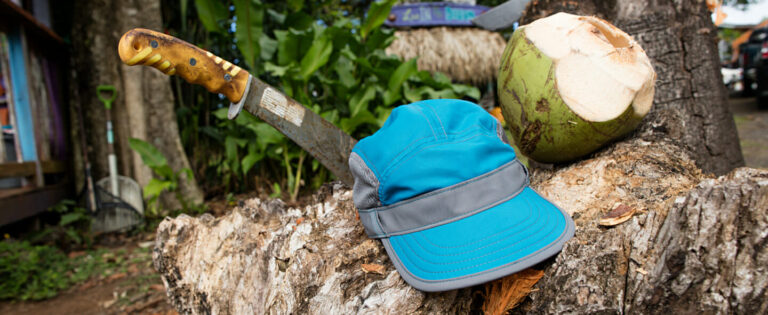Regardless of whether you’re hill walking in the Scottish Highlands or cycling through town in the rain, you’re bound to see The North Face logo somewhere along the way. There are so many people who swear by the Californian clothing brand. But, what is it about these clothes that makes them so popular other than their cool designs? We’re all familiar with the prominent logo inspired by the famous Half Dome in Yosemite National Park, but what about the writing next to it? DryVent, formerly known as HyVent.
What’s that supposed to mean? There has got to be something special about it, right? After all, it’s so popular! Besides, there’s got to be a difference between your everyday TNF jacket and a TNF jacket that you’d wear for climbing the icy cold north face of a mountain.
What exactly is DryVent?
In order to achieve both optimal weather protection and an excellent level of breathability, The North Face utilised a polyurethane (PU) coating called HyVent. This coating was developed by the Californians themselves and is used for a variety of jackets and trousers in order to make them both waterproof and breathable.
This PU coating is also found in the new DryVent technology – namely in the 2-layer and 2.5-layer materials. The coating gives the fabric a microporous and hydrophobic property, making it exceptionally breathable. The term hydrophobic is derived from Ancient Greek and means “lacking an affinity for water”. In other words, water vapour – sweat – can escape, but water in the form of rain can’t get in. This is how a high degree of breathability is achieved that won’t deteriorate over time. The garments are subject to complex tests that they have to pass even after 20 wash cycles. There is also a 3L version equipped with a membrane. We’ll get to what the individual fabrics can do later.
From city goer to alpinist
The advantage of DryVent garments is that no membrane is used (with the exception of the 3L version). This results in a very soft and comfortable garment that you can feel while you’re out and about. The 3-layer version is a bit stiffer but much tougher than the normal coating. In sum, there is a type of DryVent for almost every activity and every kind of user, regardless of whether you’re a beginner, the occasional hill walker or extreme alpinist!
The different types
In order to use DryVent to its full potential, The North Face utilises different compositions of fabric. They can be divided up into three different combinations for various applications: for everyday wear, for extended treks or for rock and ice climbing.
DryVent 2L

This is a two-layer construction that provides optimal weather protection. The outermost layer is made of a woven fabric, which reliably repels moisture and simultaneously protects from abrasion. An additional DWR (Durable Water Repellent) treatment provides optimal protection against water and moisture so that the fabric doesn’t become saturated. The inner layer utilises a DryVent PU (polyurethane) coating with micro-pores, which quickly wicks away moisture and keeps rain at bay. The end result is an absolutely waterproof and very comfortable material with a hydrostatic head of 25,000mm. It is perfect for both skiwear and everyday wear. A prime example of this is the Quest Jacket, which is an incredible value for money. DryVent 2L corresponds with what was formerly referred to as HyVent 2L.
DryVent 2.5L
Both breathability and the lowest weight possible were clearly the most important aspects here. The outermost layer is made of a water-repellent fabric, whilst the lower layer has a DryVent PU (polyurethane) coating and channels moisture to the outside through its microporous structure. Plus, it prevents rain or moisture from seeping in.
As a result of their excellent breathability, DryVent 2L garments are great for high-intensity activities such as running or cycling, no matter the weather!
DryVent 3L

Breathability, waterproofness and durability are the hallmarks of the jackets and trousers made with DryVent 3L. A relatively abrasion-resistant layer serves to protect the jacket from damage and keep moisture out of the interior. The middle layer utilises a polyurethane coating with micro-pores, which quickly moves water vapour to the outside. For even more comfort, the 3L materials have a nice inner layer, which has been engineered to provide quick moisture transfer as well.
DryVent 3L garments are perfectly suited for skiing and alpine adventures as well as climbing.
HyVent technologies that have had their day
HyVent DT
The HyVent DT is based on the same principle as the HyVent 3L with the difference that the thickness of the third layer has been significantly reduced. The HyVent DT features a 0.5 skim coat of PU, which always provides a pleasantly dry feeling and eliminates the need of a liner, hence the 2.5L material. Plus, this makes it lighter and results in a significantly smaller pack size than 3-layer materials. Thus, HyVent DT is great for activities involving a lot of movement.
HyVent DT EC
HyVent DT EC makes use of natural castor oil from beans, which reduces the use of synthetic components by 50%, but the result is still quite impressive. The fabric is waterproof, breathable and performs extremely well, even in cold conditions, which makes it perfect for winter sports.
HyVent Alpha
HyVent Alpha was used primarily in the Summit Series Collection by The North Face. The outer shell is very tough and durable. It features a DWR (Durable Water Repellent) treatment, so it will not become saturated. The outer fabric is complemented by a second layer, which allows sweat to pass through quickly and efficiently.
A thin liner is the third layer of the HyVent Alpha. It utilises a microporous and hydrophobic lamination technology that also allows sweat and moisture to pass through. This 3-layer combination serves to keep you dry and comfortable. Plus, it is extremely tough and durable. With a hydrostatic head of 30,000mm, it is totally waterproof, making it an excellent option for long and demanding trips in rain, snow and ice.
Caring for DryVent
Caring for DryVent garments is pretty straightforward. It is best to use a normal detergent designed for outdoor apparel such as TechWash from Nikwax and use a gentle cycle (no spin cycle). Then line dry the jacket. You can also restore the DWR on the outermost fabric layer by using a spray. If you do, your DryVent clothing will last for countless adventures to come!






